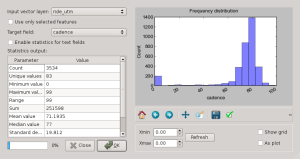Switched from Arch to Fedora
A few months back my old Dell Inspiron laptop died. It was a warhorse, surviving drops onto concrete floors, being stepped on by a big dog. The cap to the zero key popped off, and the tab key would stick from time to time but it kept on trucking. Most of the bezel around the monitor had broken / fallen off, I think this was the downfall. Finally the monitor quit working. I couldn’t work with it docked up to an external monitor so I replaced it with an ASUS K55N.
If I were a Windows only user it would be a great laptop for the price, but due to work and personal preference I’m booted into Linux 99% of the time. This suited me well on the Dell, its 2GB of RAM and aging processor made Windows molasses slow, meanwhile the Linux side hummed right along as long as I didn’t have too many browser tabs full of Flash videos open at once. However, on the ASUS I kept running into issue after issue.
First of all getting Arch onto the ASUS was a chore. Part of the problem was this was my first attempt at installing an OS onto a UEFI machine. Eventually after figuring out how to turn off the secure boot feature I was able to boot to the Arch LiveCD installer. The installation went fine until I tried to reboot and GRUB2 did not take over. For some reason the efimanager did not install or run correctly during the installation process. Eventually I switched to ReFind and figured out how to manually add an entry for it in the laptop’s boot order.
Once Arch was installed I had a few more problems to work through. Suspend wouldn’t work, I gave up on solving that issue and switched to using Hibernate instead. Another issue was with the sound system, I could not get audio to work for more than one program at a time, and once a program “claimed” the sound no other program could output to the speakers until the first program was closed. Going through pages of Google results pointed to PulseAudio as the culprit, but I could not remedy the situation. Both of these were minor annoyances, the final straw moving me from Arch to Fedora was QGIS stopped working.
The first two problems were most likely hardware related. QGIS however was an Arch only issue. The problem came about as a result of the Achilles heel of rolling release distributions, a key library was updated to a version incompatible with QGIS. I was unable to launch QGIS and compiling a new version would fail. Facing a deadline I decided to wipe Arch and move on to Fedora.
Installing Fedora was much easier than installing Arch. Partly due to the fact I was now more familiar with the ins and outs of UEFI, but also Fedora’s installer is a user friendly GUI and Arch’s installer is a wiki page on their website.
Fedora has generally run better on the ASUS. The audio system now works perfectly, but I can no longer hibernate. The laptop will hibernate, but on recovery the screen goes black. The computer is running, switching to a different TTY allows me to log in and run commands from the command line, but I can’t get the screen to come back on. I think this is due to the ATI video card and its radeon driver. Hopefully I can find a solution soon.
I was able to get my GIS stack installed, all of the programs I use are in Fedora’s repository. I did have to make a change to GDAL, I use several non-open GIS data formats (ESRI File Geodatabases, MrSID rasters, and ERDAS ecw rasters). Under Arch it was just a matter of downloading the appropriate API or SDK, altering the default PKGBUILD file to point to the appropriate libraries and recompiling. Under Fedora you have to edit the SPEC file, and SPEC files are much more complicated that Arch’s PKGBUILD files. In addition Fedora’s package management system expects any libraries that a packaged program is complied against to be accounted for in a package. Eventually I got it all sorted out and I got back to work.
I’m still too new to Fedora to do a comparison between it and Arch. Certainly installing Fedora is much easier than installing Arch. For day to day use they are about the same, in fact since I kept my /home on a separate partition they are nearly identical experiences. Both use systemd to manage services, and both give you up to date software. That was one worry about moving to Fedora, Arch’s rolling release always gave me easy access to the latest versions of the software I used on a daily basis. Although Fedora isn’t rolling release all of the software I use is the latest and greatest. QGIS, PostGIS, Postgres, LibreOffice, etc are all up to date. As I said earlier the rub comes when I need to tweak software from the Fedora default. Perhaps it will get easier for me as time goes on, or perhaps I’ll flush my root directory and reinstall Arch.
